MITSUBISHI L200 2015 Owner's Manual (in English)
Manufacturer: MITSUBISHI, Model Year: 2015, Model line: L200, Model: MITSUBISHI L200 2015Pages: 418, PDF Size: 25.8 MB
Page 141 of 418
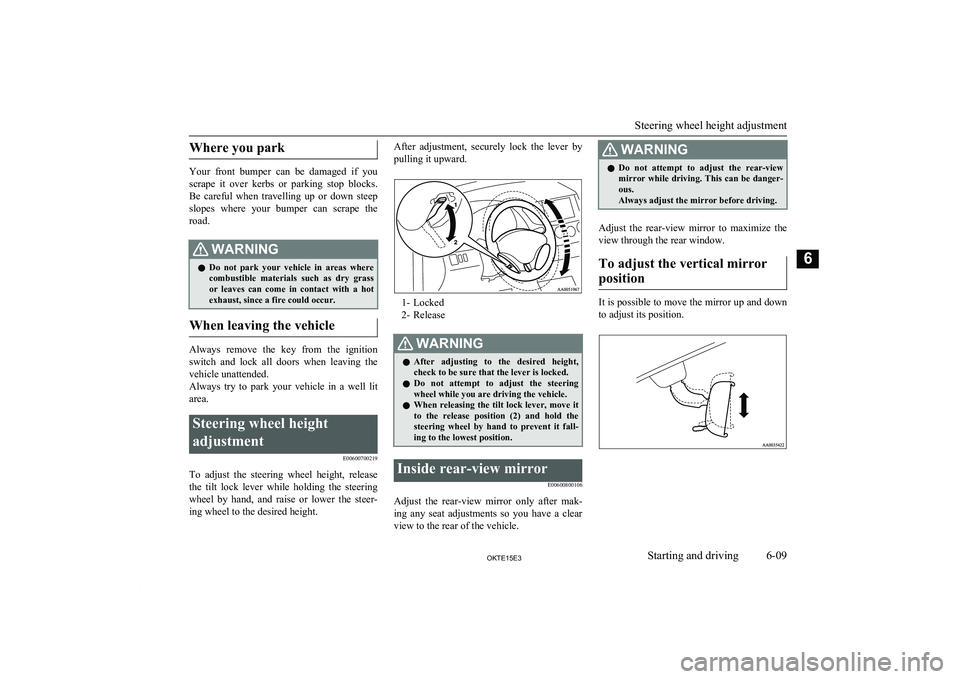
Where you park
Your front bumper can be damaged if you
scrape it over kerbs or parking stop blocks.
Be careful when travelling up or down steep slopes where your bumper can scrape theroad.
WARNINGl Do not park your vehicle in areas where
combustible materials such as dry grass
or leaves can come in contact with a hot
exhaust, since a fire could occur.
When leaving the vehicle
Always remove the key from the ignition
switch and lock all doors when leaving the vehicle unattended.
Always try to park your vehicle in a well lit
area.
Steering wheel height
adjustment E00600700219
To adjust the steering wheel height, releasethe tilt lock lever while holding the steering
wheel by hand, and raise or lower the steer- ing wheel to the desired height.
After adjustment, securely lock the lever by
pulling it upward.
1- Locked
2- Release
WARNINGl After adjusting to the desired height,
check to be sure that the lever is locked.
l Do not attempt to adjust the steering
wheel while you are driving the vehicle.
l When releasing the tilt lock lever, move it
to the release position (2) and hold the
steering wheel by hand to prevent it fall- ing to the lowest position.Inside rear-view mirror
E00600800106
Adjust the rear-view mirror only after mak-
ing any seat adjustments so you have a clear
view to the rear of the vehicle.
WARNINGl Do not attempt to adjust the rear-view
mirror while driving. This can be danger-
ous.
Always adjust the mirror before driving.
Adjust the rear-view mirror to maximize the
view through the rear window.
To adjust the vertical mirror position
It is possible to move the mirror up and down
to adjust its position.
Steering wheel height adjustment
6-09OKTE15E3Starting and driving6
Page 142 of 418
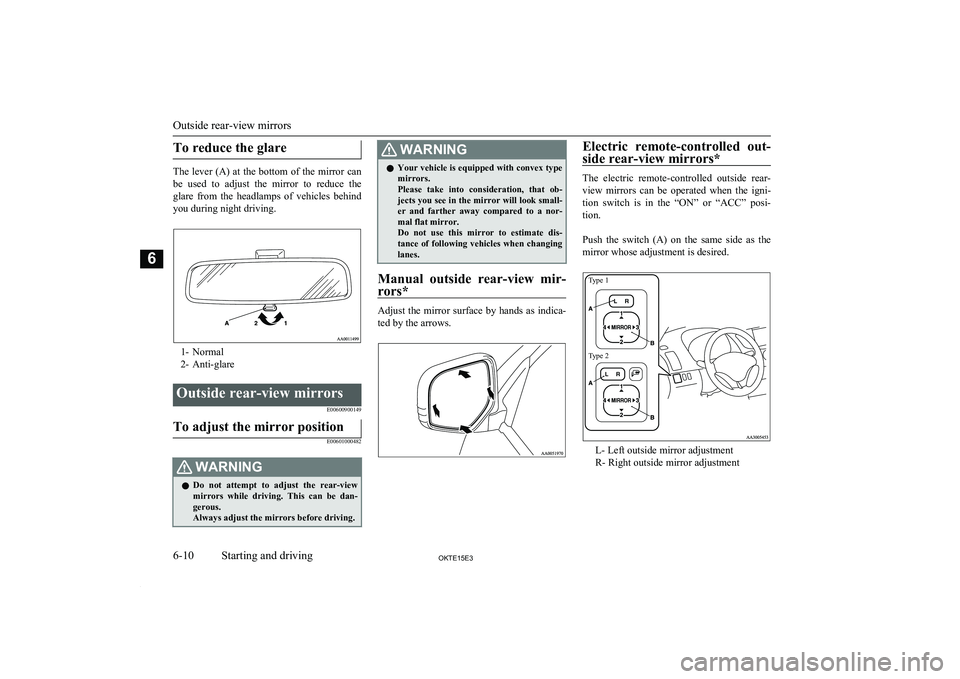
To reduce the glare
The lever (A) at the bottom of the mirror canbe used to adjust the mirror to reduce the
glare from the headlamps of vehicles behind
you during night driving.
1- Normal
2- Anti-glare
Outside rear-view mirrors
E00600900149To adjust the mirror position
E00601000482WARNINGlDo not attempt to adjust the rear-view
mirrors while driving. This can be dan-
gerous.
Always adjust the mirrors before driving.WARNINGl Your vehicle is equipped with convex type
mirrors.
Please take into consideration, that ob- jects you see in the mirror will look small-er and farther away compared to a nor-mal flat mirror.
Do not use this mirror to estimate dis-
tance of following vehicles when changing lanes.
Manual outside rear-view mir-
rors*
Adjust the mirror surface by hands as indica-
ted by the arrows.
Electric remote-controlled out-
side rear-view mirrors*
The electric remote-controlled outside rear-view mirrors can be operated when the igni-
tion switch is in the “ON” or “ACC” posi- tion.
Push the switch (A) on the same side as the
mirror whose adjustment is desired.
Type 1Type 2
L- Left outside mirror adjustment
R- Right outside mirror adjustment
Outside rear-view mirrors
6-10OKTE15E3Starting and driving6
Page 143 of 418
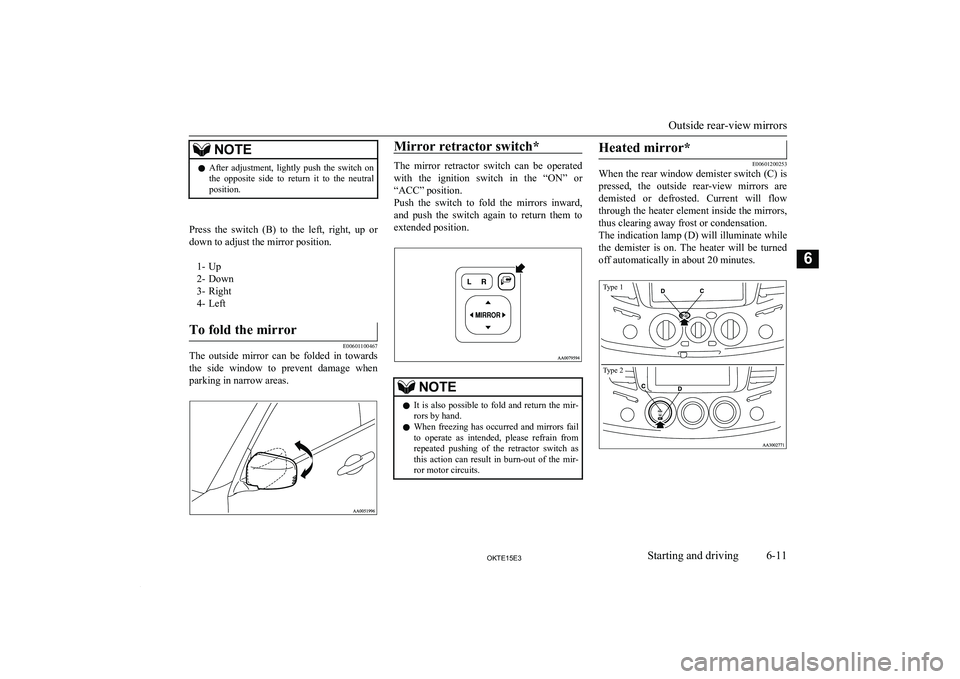
NOTElAfter adjustment, lightly push the switch on
the opposite side to return it to the neutral
position.
Press the switch (B) to the left, right, up or down to adjust the mirror position.
1- Up
2- Down
3- Right
4- Left
To fold the mirror
E00601100467
The outside mirror can be folded in towards the side window to prevent damage when
parking in narrow areas.
Mirror retractor switch*
The mirror retractor switch can be operated
with the ignition switch in the “ON” or
“ACC” position.
Push the switch to fold the mirrors inward,
and push the switch again to return them to extended position.
NOTEl It is also possible to fold and return the mir-
rors by hand.
l When freezing has occurred and mirrors fail
to operate as intended, please refrain from repeated pushing of the retractor switch as
this action can result in burn-out of the mir-
ror motor circuits.Heated mirror*
E00601200253
When the rear window demister switch (C) is
pressed, the outside rear-view mirrors aredemisted or defrosted. Current will flow
through the heater element inside the mirrors, thus clearing away frost or condensation.
The indication lamp (D) will illuminate while the demister is on. The heater will be turned
off automatically in about 20 minutes.
Type 1Type 2
Outside rear-view mirrors
6-11OKTE15E3Starting and driving6
Page 144 of 418
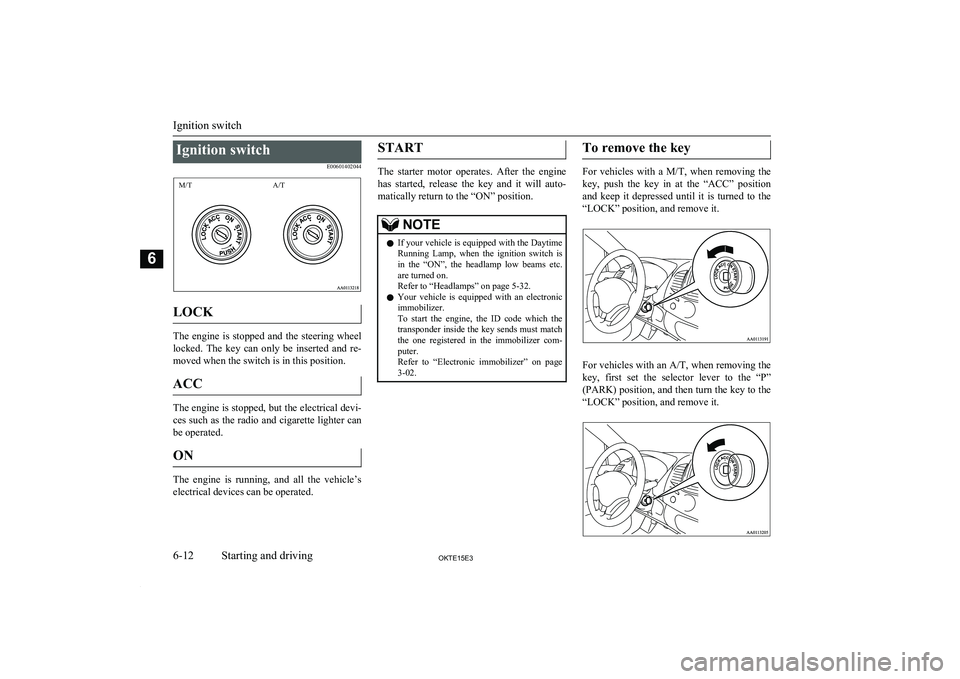
Ignition switchE00601402044
M/TA/T
LOCK
The engine is stopped and the steering wheel
locked. The key can only be inserted and re- moved when the switch is in this position.
ACC
The engine is stopped, but the electrical devi- ces such as the radio and cigarette lighter can
be operated.
ON
The engine is running, and all the vehicle’selectrical devices can be operated.
START
The starter motor operates. After the engine
has started, release the key and it will auto-
matically return to the “ON” position.
NOTEl If your vehicle is equipped with the Daytime
Running Lamp, when the ignition switch is
in the “ON”, the headlamp low beams etc. are turned on.
Refer to “Headlamps” on page 5-32.
l Your vehicle is equipped with an electronic
immobilizer.
To start the engine, the ID code which the transponder inside the key sends must match
the one registered in the immobilizer com- puter.
Refer to “Electronic immobilizer” on page 3-02.To remove the key
For vehicles with a M/T, when removing the
key, push the key in at the “ACC” position
and keep it depressed until it is turned to the “LOCK” position, and remove it.
For vehicles with an A/T, when removing the
key, first set the selector lever to the “P”
(PARK) position, and then turn the key to the “LOCK” position, and remove it.
Ignition switch
6-12OKTE15E3Starting and driving6
Page 145 of 418
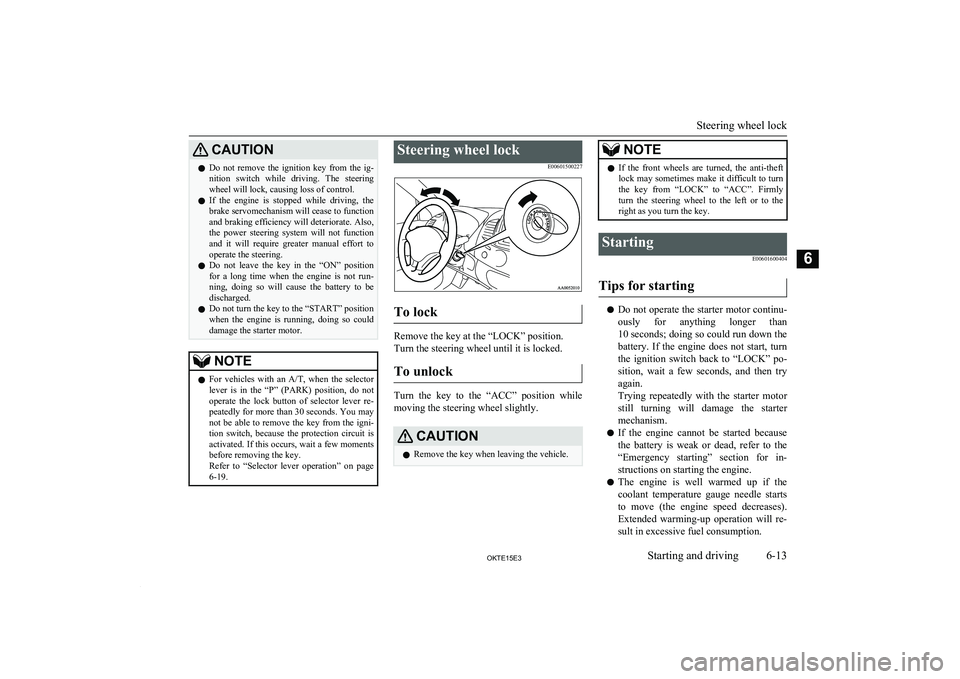
CAUTIONlDo not remove the ignition key from the ig-
nition switch while driving. The steeringwheel will lock, causing loss of control.
l If the engine is stopped while driving, the
brake servomechanism will cease to function and braking efficiency will deteriorate. Also,
the power steering system will not function
and it will require greater manual effort to
operate the steering.
l Do not leave the key in the “ON” position
for a long time when the engine is not run- ning, doing so will cause the battery to be
discharged.
l Do not turn the key to the “START” position
when the engine is running, doing so could damage the starter motor.NOTEl For vehicles with an
A/T, when the selector
lever is in the “P” (PARK) position, do not operate the lock button of selector lever re-
peatedly for more than 30 seconds. You may
not be able to remove the key from the igni-
tion switch, because the protection circuit is
activated. If this occurs, wait a few moments before removing the key.
Refer to “Selector lever operation” on page
6-19.Steering wheel lock
E00601500227
To lock
Remove the key at the “LOCK” position.
Turn the steering wheel until it is locked.
To unlock
Turn the key to the “ACC” position while
moving the steering wheel slightly.
CAUTIONl Remove the key when leaving the vehicle.NOTElIf the front wheels are turned, the anti-theft
lock may sometimes make it difficult to turnthe key from “LOCK” to “ACC”. Firmly
turn the steering wheel to the left or to the right as you turn the key.Starting
E00601600404
Tips for starting
lDo not operate the starter motor continu-
ously for anything longer than10 seconds ; doing so could run down the
battery. If the engine does not start, turn
the ignition switch back to “LOCK” po-
sition, wait a few seconds, and then try again.
Trying repeatedly with the starter motor still turning will damage the starter
mechanism.
l If the engine cannot be started because
the battery is weak or dead, refer to the“Emergency starting” section for in- structions on starting the engine.
l The engine is well warmed up if the
coolant temperature gauge needle starts
to move (the engine speed decreases).
Extended warming-up operation will re-
sult in excessive fuel consumption.
Steering wheel lock
6-13OKTE15E3Starting and driving6
Page 146 of 418
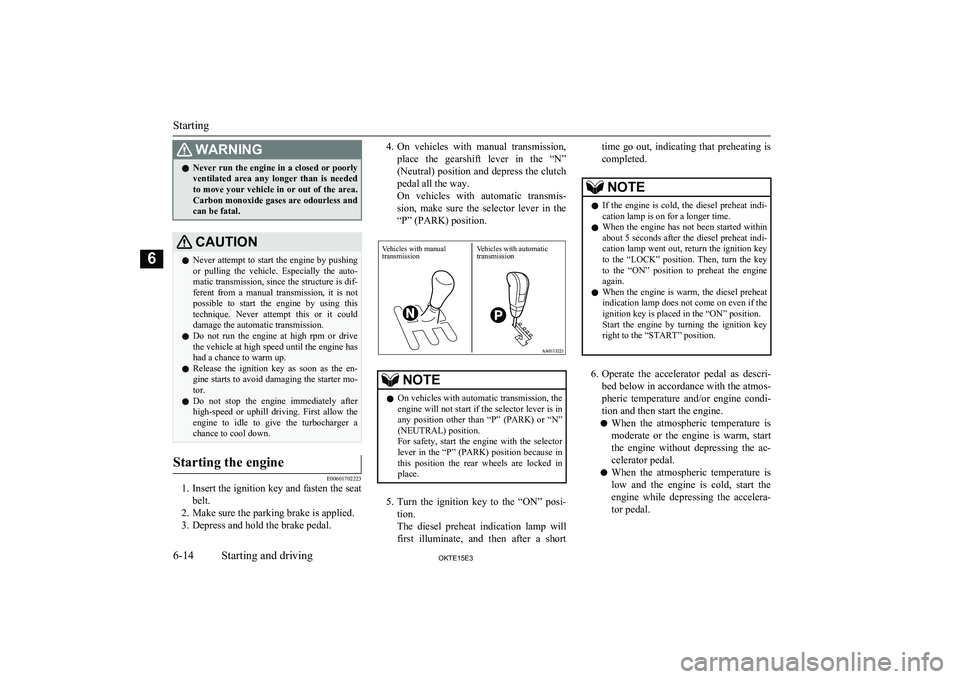
WARNINGlNever run the engine in a closed or poorly
ventilated area any longer than is needed
to move your vehicle in or out of the area. Carbon monoxide gases are odourless and can be fatal.CAUTIONl Never attempt to start the engine by pushing
or pulling the vehicle. Especially the auto-matic transmission, since the structure is dif-
ferent from a manual transmission, it is not possible to start the engine by using this
technique. Never attempt this or it could damage the automatic transmission.
l Do not run the engine at high rpm or drive
the vehicle at high speed until the engine has had a chance to warm up.
l Release the ignition key as soon as the en-
gine starts to avoid damaging the starter mo-
tor.
l Do not stop the engine immediately after
high-speed or uphill driving. First allow the
engine to idle to give the turbocharger a
chance to cool down.Starting the engine
E00601702223
1. Insert the ignition key and fasten the seat
belt.
2. Make sure the parking brake is applied.
3. Depress and hold the brake pedal.
4. On vehicles with manual transmission,
place the gearshift lever in the “N” (Neutral) position and depress the clutch
pedal all the way.
On vehicles with automatic transmis- sion, make sure the selector lever in the “P” (PARK) position.NOTEl On vehicles with automatic transmission, the
engine will not start if the selector lever is inany position other than “P” (PARK) or “N”
(NEUTRAL) position.
For safety, start the engine with the selector lever in the “P” (PARK) position because in
this position the rear wheels are locked in place.
5. Turn the ignition key to the “ON” posi-
tion.
The diesel preheat indication lamp will first illuminate, and then after a short
time go out, indicating that preheating is
completed.NOTEl If the engine is cold, the diesel preheat indi-
cation lamp is on for a longer time.
l When the engine has not been started within
about 5 seconds after the diesel preheat indi- cation lamp went out, return the ignition key
to the “LOCK” position. Then, turn the key
to the “ON” position to preheat the engine
again.
l When the engine is warm, the diesel preheat
indication lamp does not come on even if the
ignition key is placed in the “ON” position.
Start the engine by turning the ignition key
right to the “START” position.
6. Operate the accelerator pedal as descri-
bed below in accordance with the atmos- pheric temperature and/or engine condi-
tion and then start the engine.
l When the atmospheric temperature is
moderate or the engine is warm, start
the engine without depressing the ac-
celerator pedal.
l When the atmospheric temperature is
low and the engine is cold, start the
engine while depressing the accelera- tor pedal.
Starting
6-14OKTE15E3Starting and driving6 Vehicles with manual transmissionVehicles with automatictransmission
Page 147 of 418

Fuel injection amount learningprocess
E00616000028
To keep exhaust emissions and engine noise
low, the engine very occasionally performs a
learning process for the fuel injection
amount.
The engine sounds slightly different from
usual while the learning process is taking place. The change in the engine sound does
not indicate a fault.
Diesel particulate filter
(DPF)* E00619800232
The diesel particulate filter (DPF) is a devicethat captures most of the particulate matter
(PM) in the exhaust emissions of the diesel engine. The DPF automatically burns away trapped PM during vehicle operation. Under
certain driving conditions, however, the DPF is not able to burn away all of the trapped PM
and, as a result, an excessive amount of PM accumulates inside it.
WARNINGl The DPF reaches very high temperatures.
Do not park your vehicle in areas where
combustible materials such as dry grass
or leaves can come in contact with a hot exhaust system since a fire could occur.CAUTIONl Do not use any type of fuel or engine oil that
is not specified for your vehicle. Also, do not use any moisture-removing agent or oth-
er fuel additive. Such substances could have a detrimental effect on the DPF.
Refer to “Fuel selection” on page 2-02 and
“Engine oil” on page 10-04.NOTEl To minimize the likelihood of excessive ac-
cumulation of PM, try to avoid driving for long periods at low speeds and repeatedly
driving short distances.DPF warning lamp
The DPF warning lamp comes on or flashes
in the event of an abnormality in the DPF system. Provided the DPF system is workingnormally, the DPF warning lamp comes on
when the ignition switch is turned to the “ON” position and goes off a few seconds
later.
If the DPF warning lamp
comes on during vehicle opera- tion
Steady illumination of the DPF warning lamp shows that the DPF has not been able to burn
away all of the trapped PM and that, as a re-
sult, an excessive amount of PM has accumu- lated inside it. To enable the DPF to burn
away the PM, try to drive the vehicle as fol-
lows:
Diesel particulate filter (DPF)*
6-15OKTE15E3Starting and driving6
Page 148 of 418
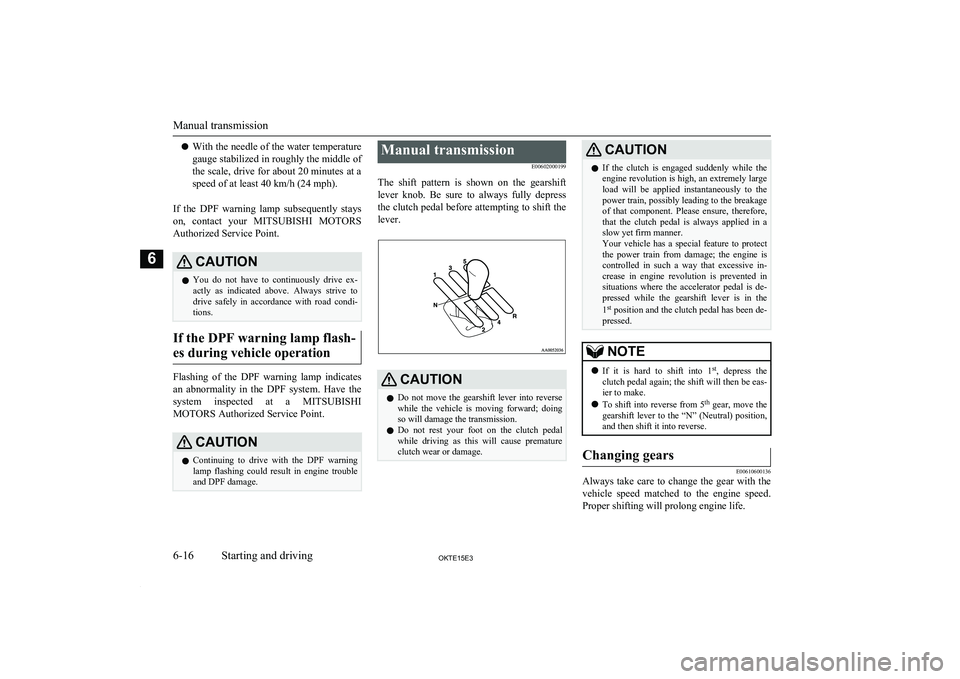
lWith the needle of the water temperature
gauge stabilized in roughly the middle of the scale, drive for about 20 minutes at a
speed of at least 40 km/h (24 mph).
If the DPF warning lamp subsequently stays
on, contact your MITSUBISHI MOTORS
Authorized Service Point.CAUTIONl You do not have to continuously drive ex-
actly as indicated above. Always strive todrive safely in accordance with road condi-
tions.
If the DPF warning lamp flash-
es during vehicle operation
Flashing of the DPF warning lamp indicates an abnormality in the DPF system. Have the system inspected at a MITSUBISHI
MOTORS Authorized Service Point.
CAUTIONl Continuing to drive with the DPF warning
lamp flashing could result in engine trouble
and DPF damage.Manual transmission
E00602000199
The shift pattern is shown on the gearshift lever knob. Be sure to always fully depress
the clutch pedal before attempting to shift the lever.CAUTIONl Do not move the gearshift lever into reverse
while the vehicle is moving forward; doingso will damage the transmission.
l Do not rest your foot on the clutch pedal
while driving as this will cause premature
clutch wear or damage.CAUTIONl If the clutch is engaged suddenly while the
engine revolution is high, an extremely large
load will be applied instantaneously to the
power train, possibly leading to the breakage of that component. Please ensure, therefore,that the clutch pedal is always applied in aslow yet firm manner.
Your vehicle has a special feature to protect
the power train from damage; the engine is controlled in such a way that excessive in-crease in engine revolution is prevented in
situations where the accelerator pedal is de-
pressed while the gearshift lever is in the
1 st
position and the clutch pedal has been de-
pressed.NOTEl If it is hard to shift into 1 st
, depress the
clutch pedal again; the shift will then be eas- ier to make.
l To shift into reverse from
5th
gear , move the
gearshift lever to the “N” (Neutral) position, and then shift it into reverse.Changing gears
E00610600136
Always take care to change the gear with the
vehicle speed matched to the engine speed.
Proper shifting will prolong engine life.
Manual transmission
6-16OKTE15E3Starting and driving6
Page 149 of 418
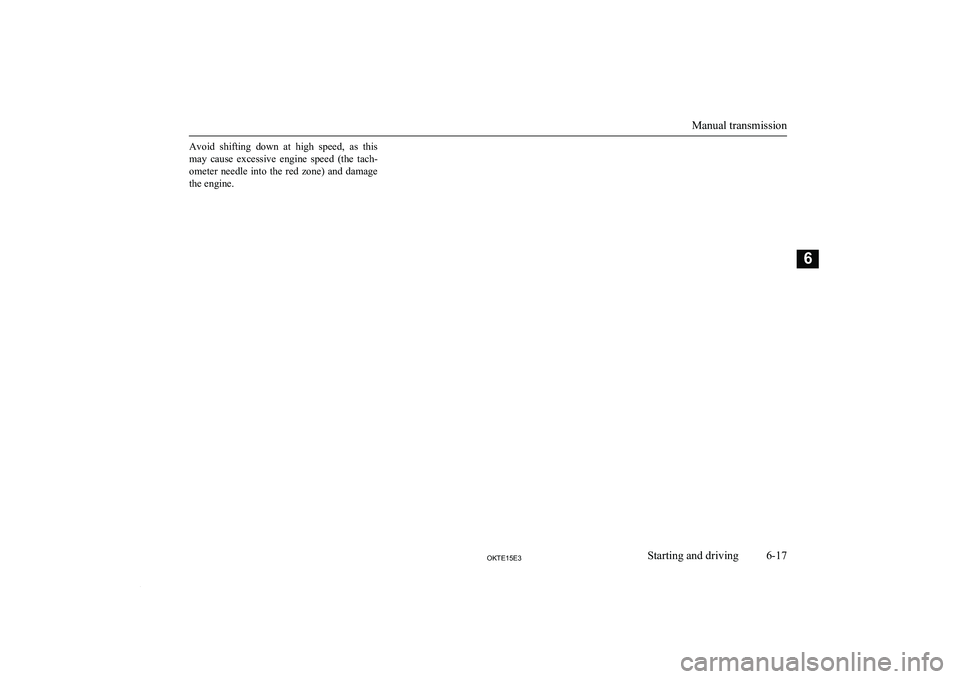
Avoid shifting down at high speed, as this
may cause excessive engine speed (the tach- ometer needle into the red zone) and damage
the engine.
Manual transmission
6-17OKTE15E3Starting and driving6
Page 150 of 418
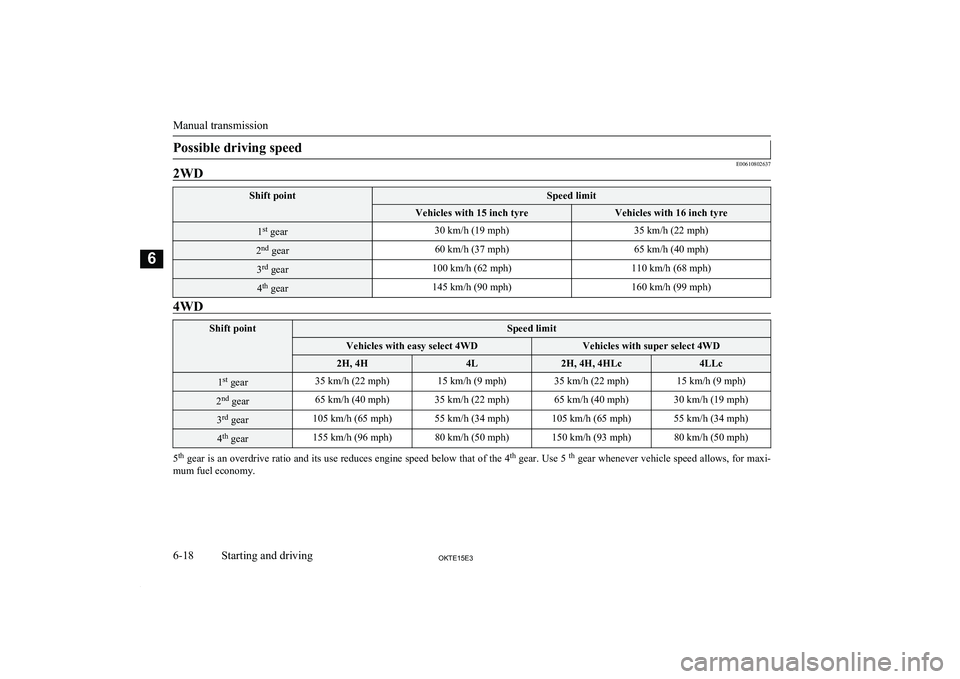
Possible driving speed
E00610802637
2WDShift pointSpeed limitVehicles with 15 inch tyreVehicles with 16 inch tyre1st
gear30 km/h (19 mph)35 km/h (22 mph)2nd
gear60 km/h (37 mph)65 km/h (40 mph)3rd
gear100 km/h (62 mph)110 km/h (68 mph)4th
gear145 km/h (90 mph)160 km/h (99 mph)4WDShift pointSpeed limitVehicles with easy select 4WDVehicles with super select 4WD2H, 4H4L2H, 4H, 4HLc4LLc1st
gear35 km/h (22 mph)15 km/h (9 mph)35 km/h (22 mph)15 km/h (9 mph)2 nd
gear65 km/h (40 mph)35 km/h (22 mph)65 km/h (40 mph)30 km/h (19 mph)3rd
gear105 km/h (65 mph)55 km/h (34 mph)105 km/h (65 mph)55 km/h (34 mph)4th
gear155 km/h (96 mph)80 km/h (50 mph)150 km/h (93 mph)80 km/h (50 mph)
5th
gear is an overdrive ratio and its use reduces engine speed below that of the 4 th
gear. Use 5 th
gear whenever vehicle speed allows, for maxi-
mum fuel economy.
Manual transmission
6-18OKTE15E3Starting and driving6